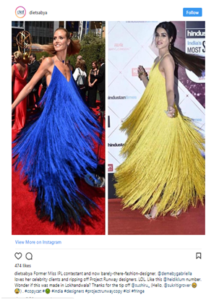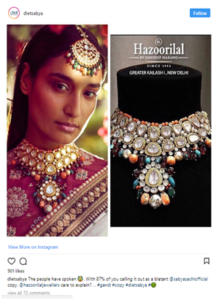“The motifs on my jackets were hand-drawn and hand-embroidered. The collection is still selling, and one piece is sold for Rs. 40,000. However, one brand is re-creating the motifs as digital prints and selling it for Rs. 1,500.
– Designer Rahul Mishra in an interview to Times of India on 13 May 2018.
‘Inspiration’, ‘Homage’ and ‘Dedication’ are few words that designers use shamelessly while ‘Copying’, ‘Infringing’ or ‘Plagiarising’ other’s design and fashion works. Earlier, clothing was necessity and hence seen in a utilitarian aspect. However, with changing times fashion has grown from utilitarian to artistic creations.With ever-increasing fashion industry, there are huge cries amongst the designer whose works are blatantly being ripped off. Every Indian on the streets of Chandni Chowk, Delhi or Linking Road, Mumbai has been witness to knockouts and counterfeits of Sabyasachi’s lehengas and Manish Malhotra’s fashion week designer outfits. The reason being weak IP laws pertaining to fashion industry.
The lingering issue of Copyright protection in the Fashion industry has revived again due to internet sensation ‘Diet Sabya’. Diet Sabya is an anonymous Instagram page and desi-version of Diet Prada. The page calls out plagiarised fashion design works by comparing it on side-to-side basis. It has garnered attention of many in a short span of time with various celebrities appreciating the cause and various others fuming it.

The relation of fashion and copyright has always been complicated. IP protection via trademark is limited in its scope. It will cover only those patters or marks which helps the brand in its attaining its distinctiveness. Famous examples include Christian Louboutin and its trademarked red sole on footwear. However, Copyright is an IP protection which can save the drowning boat of designers. However, it comes with a set of its own problems.
The Scope of Copyright Protection
Getting a copyright registration is not necessary. A copyright exists as soon as the work is created. The first question then arises is whether a design is a work under Section 13 of the Copyright Act, 1957? Artistic work under Section 2(c) includes drawings, among other things. The sketches of the designs are drawings and can be protected under the Act. Also, copyright in artistic work includes conversion of 2D work into 3D work. So, when a drawing or sketch of a dress is converted into an actual dress, it would still enjoy the protection of Copyright.
The problem starts with Section 15 of the Copyright Act which provides that there cannot be any dual protection of design. It means that one cannot protect his design under Copyright Act as well as Design Act. If an Applicant wants Copyright protection for his design, he needs to submit an affidavit stating that the design is not enjoying protection under the Designs Act. The clause 2 of the said section also states that a copyright in any design which has not been registered under the Designs Act will cease as soon as the Article is reproduced more than 50 times by an industrial process.
Hence, the dilemma starts. Whether the work of fashion should be protected under Copyright Act or Designs Act? There is no definite answer to this. Some may prefer Copyright registration as it gives protection for more years than what Designs Act could give. On the other hand, some feel that there could be no purpose of registering a fashion work under the Copyright Act if it cannot be reproduced more than 50 times.
Another pitfall with copyright registration is that fashion is all about trends. It phases out every season. Getting a copyright registration takes its own time and there is a possibility that by the time the creator gets the registration, the fashion trend phases out.
In the case of Tahiliani Design Pvt. Ltd. v. 2008 PTC (38) 251, Delhi High Court deliberated the engagement of the regime of copyright and design law to decide an infringement suit. It was India’s first full-fledged battle on creative integrity. The Court held that intent of the Legislature is clear from the words of the Act. There is a deliberate exclusion of ‘artistic work’ from the definition of ‘design’ under the Designs Act, 2000. Further the Court held that “uniqueness not only in conceptualization but also in creation and presentation are sine qua non of haute couture.”
The other case which deliberated on the same issue was Microfibres v. Girdhar & Co.2009 (40) PTC 519 where the Division Bench of Delhi High Court held that the Legislature has always treated commerce and art as different things. The activity which is commercial in nature has to be granted lesser period of protection and hence Section 15(2) of the Copyright Act exists.
France currently is the only country having strong copyright laws for protecting fashion works. The statutory protection comes in the form of Article L. 112-2.73 in the Code de la Propriete Intellectuelle. The Code lists “the creations of the seasonal industries of dress and articles of” as a protected subject matter, and “uniform protection is given to original fashion designs automatically on the date of creation, regardless of registration, unlike different protection schemes given to registered and unregistered designs under the European Union regulations.”
There is another theory in IP protection and fashion works. Some feel that the weak IP protection to fashion works are boon. It encourages people to be more creative and think out of the box. If there were strong protection, no one would have thought of coming out with aluminium or steel plated boots. To think of, replicating or creating counterfeits of such steel-plated boots would be impractical as the essence lies in the material itself. Reproducing in a cheaper material would make the fashion useless and hence is secured without IP protection. But the question remains standstill. What about other designers whose designs could still be counterfeited with cheaper materials? A slight change in the material or patterns are still enabling infringers get away easily from the legal hands.
Recently, Designer Sabyasachi Mukherjee was awarded the National Intellectual Property Award 2018 in the field of designs and commercialisation for holding the copyright on more than 700 of his designs. His was the first design house to receive the award. In an interview he said, “It is expensive to register every single design, but it helps us to break the notion that the fashion industry is frivolous and doesn’t understand such complexities.”
On the issue of Copyright and fashion works, FDCI President Sunil Sethi stated that the Nandi bull by Designer Rohit Bal cannot be copyrighted. But the interpretation of embroidery makes the difference. By copyrighting such works, there will be better awareness and signature recall which will make imitation difficult in the fashion industry.
Author: – Esha Himadri, Intern at Khurana & Khurana, Advocates and IP Attorneys. Can be reached at swapnil@khuranaandkhurana.com.
References:
[2]https://www.nytimes.com/2018/02/06/business/christian-louboutin-shoes-red-trademark.html
[4]Tahiliani Design Pvt. Ltd. v. Rajesh Masrani, 2008 PTC (38) 251 (Del.)
[5] Microfibres Inc. v. Girdhar & Co. &Anr., 2009 40 PTC 519 (Del)
[6] http://www.dailypioneer.com/vivacity/bal-protects-his-original-line.html




